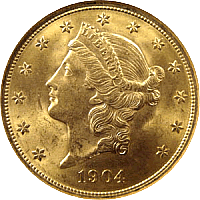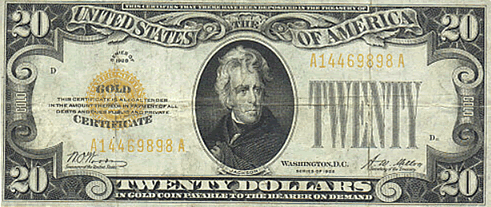The Lesson
By Dr. Steve Sjuggerud
February 26, 2007
"[Dollar bills] have no value for themselves, but for what they will buy." |
| – from the website of the U.S. Treasury |
Dollar bills actually have no value... And our government actually tells us that... right here.
But somehow, we believe they do. We save dollars like they're valuable... After your home, dollars in the bank are probably your second-largest asset. People seem to be completely oblivious to the fact that their second-biggest possession of wealth has absolutely no inherent value.
While we don't think much about this, it drives Burt Blumert crazy...
Since I'm out in San Francisco, I went to visit Burt. Burt, if you don't know, started Camino Coin back in 1959. With a half century of experience dealing in money and gold, Burt knows a thing or two about the topic. Whenever I'm in San Francisco, I stop in and see him. He's two minutes from the airport.
Burt Blumert has given me The Lesson before. But, like it or not, I was going to get it again. And besides, my publisher, Porter Stansberry, had never had The Lesson.
---------- Advertisement ----------
How You Can Receive All of Dr. Sjuggerud’s Investment Research
If you like the work Dr. Sjuggerud does - and you want to continue receiving it - you can take advantage of the absolute best deal we have ever offered... But this deal only lasts until midnight tonight.
We’re prepared to save you literally thousands of dollars on all the research Steve currently publishes – including two new services to come in 2007.
With this deal, you will save $1,309 this year alone. You’ll save $5,210 after the first two years. And more than $7,901 over the next three years...
After tonight at midnight, you will never see this price again.
Click here for the details.
-----------------------------------
It’s a simple bit of show-and-tell about the value of money from Burt, with some startling conclusions...
 |
Burt took us back to the "silver room" in his office, where silver bars are strewn around like discarded Kleenexes. He pulled out a "$20 Liberty" gold coin that looks something like this one to the right:
"In my lifetime, this coin really was worth $20," Burt told us.
It's brilliant. It's big. And it's heavy. $20 gold coins like this contain just under an ounce of gold. Today, an ounce of gold is worth around $680 dollars.
A $20 bill is worth $20. But a $20 gold coin could be melted down for $660 worth of gold.
This coin was money in Burt's lifetime... It is a real representation of the destruction in the value of a dollar during that lifetime.
This is the first part of Burt's visual lesson... "Steve, this destruction of wealth will continue. It is inevitable. Fortunately, you can protect yourself from it. And you must."
Burt's show-and-tell continued... Next up was a gold certificate...
Gold coins have been money for centuries. Yet gold certificates started to appear in the U.S. in the late 1880s. Certificates were fine... they represented gold coins in a vault. But they were one step away from the real gold. Burt pulled out a $20 bill here from 1928 to make another point:
 |
While it looks almost identical to recent $20 bills, there is a crucial difference... across the top in small letters, it says: "This Certifies that There Have Been Deposited in the Treasury of the United State of America" then across the bottom "Twenty Dollars in Gold Coin Payable to the Bearer on Demand."
The next chapter in the story was far more drastic. Gold ownership was outlawed in the U.S. in the 1930s. (No kidding. You were forced to turn in your gold.) The United States, in essence, moved to a silver standard.
At first, silver certificates circulated, with the same promise as the gold certificate above. But the degradation of the promise to pay continued... Then, the promise took out the portion about being payable in coin. By the 1960s, they were no longer redeemable in silver.
The visual lesson continues. "Steve, please pull a dollar out of your wallet... What promise is written on it? What does that dollar entitle you to? What, exactly is stored in a vault somewhere that you have a claim to?"
The answer, of course, is "absolutely nothing." End of visual lesson.
Even the U.S. Treasury admits it. "Federal Reserve notes [dollar bills] are not redeemable in gold, silver or any other commodity, and receive no backing by anything. The notes have no value for themselves, but for what they will buy."
In the last five years, the price of gold has more than doubled. Said another way, it takes twice as many paper dollars to buy an ounce of gold today than it did just a few years ago.
At the same time, the U.S. dollar has weakened by about 30% versus the other major currencies of the world.
Why are dollars your second-biggest holding?
You really must sell some worthless paper and own the real asset, or as Burt would likely argue, the only real money – gold.
I have recommended my readers buy their raw gold coins from Burt Blumert for many years now. Burt's track record of taking good care of my readers is just fantastic.
Burt does a great job. I don't know how he makes any money at it... For example, he sells coins, like the beautiful 1904 Liberty $20 gold coin, for just 7% over it's meltdown value. These things are not typical gold coins that could have been minted yesterday. This is a 100-year-old coin.
With that tiny premium over melt for this piece of history, Burt has to pay his employees, keep the lights on, pay taxes, etc. I don't know how he can sell them at a 7% premium and make a profit. But I'm thankful he does it for my readers.
You don't have to be a paid subscriber of mine to get this deal from Burt. You can give him a call at 800-348-8001 or burtblumert@comcast.net He also has a web page here:
http://www.lewrockwell.com/blumert/burt-gold.html
Burt's lesson is powerful. A dollar has no value, and can be printed indiscriminately by the government. But governments can't print gold.
If you don't own any gold, or don't own enough, Burt is a good man to call...
Good investing,
Steve
No comments:
Post a Comment